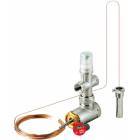Intercepting valves, suitable for all types of fuel
For methane gas, the intercepting valves must be chosen by reducing, as much as possible, the losses in loading

When we’re choosing the intercepting valves to be applied on an installation, we must keep in mind a number of factors. The choice of diameter indeed depends on the type of fuel that we intend to transport in order to feed the generator.
Usually, 1/2’’ intercepting valves are used in diesel installations, whereas for heavier fuelling oils we must opt for larger diameters, which allow a higher transition speed and, thus, definitely lower turbulence. Often, the dimension of these dense-oil installations is also greater.
In the case of gas installations (especially methane), it is important to factor potential loss of load into the choice of intercepting valves, as this could make it so that the pressure arriving to the burner wouldn’t be sufficient. One must also consider that during winter periods, the pressure might also experience a decrease due to the higher demand.
The intercepting valves have a positive kind of safety. This allows in any situation, even in the case of damage to the capillary tube connecting the valve to the probe, a shutting-intervention to the conveying. This situation can be then restored only once the installation’s parameters are regularised again.
Usually, 1/2’’ intercepting valves are used in diesel installations, whereas for heavier fuelling oils we must opt for larger diameters, which allow a higher transition speed and, thus, definitely lower turbulence. Often, the dimension of these dense-oil installations is also greater.
In the case of gas installations (especially methane), it is important to factor potential loss of load into the choice of intercepting valves, as this could make it so that the pressure arriving to the burner wouldn’t be sufficient. One must also consider that during winter periods, the pressure might also experience a decrease due to the higher demand.
The intercepting valves have a positive kind of safety. This allows in any situation, even in the case of damage to the capillary tube connecting the valve to the probe, a shutting-intervention to the conveying. This situation can be then restored only once the installation’s parameters are regularised again.
20/08/2015
I contenuti di questo sito non hanno carattere di periodicità e non rappresentano 'prodotto editoriale'.








